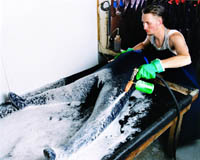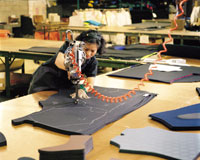Neoprene is a modern miracle! There is no other fabric with all these qualities: it stretches, it's waterproof, it can be stitched or glued, it comes in a multitude of colors, it provides an insulating layer in wet environments, it's abrasion resistant and it is relatively inexpensive.
Neoprene was first discovered by none other than Jacques Cousteau. His pioneering efforts after WWII created a material suitable for diving in the frigid depths of the ocean. This initial material is quite different from what we use today but the technology to produce it is similar.
How Neoprene is Made
 Neoprene is often referred to as 'rubber' but it is actually plastic. It begins as a powder called polychloroprene. To this base are added other ingredients that provide elasticity, foaming agents, cell size, color, adhesion, bulk, plus other properties. This mixture is made into a dough which is put into a heat press. Under pressure and heat, the mixture squishes out to make a sheet about 90" x 53". Sheet size varies according to the manufacturer and type of neoprene being produced. Jacques Cousteau's original method is still being used by a company called Rub Tex in California, which also produces car door moldings for GM.
Neoprene is often referred to as 'rubber' but it is actually plastic. It begins as a powder called polychloroprene. To this base are added other ingredients that provide elasticity, foaming agents, cell size, color, adhesion, bulk, plus other properties. This mixture is made into a dough which is put into a heat press. Under pressure and heat, the mixture squishes out to make a sheet about 90" x 53". Sheet size varies according to the manufacturer and type of neoprene being produced. Jacques Cousteau's original method is still being used by a company called Rub Tex in California, which also produces car door moldings for GM.
The final product is a foam block about 2" thick. The top and bottom of the block will be either smooth skin or textured. The sheet is then cut horizontally to produce sheets anywhere from 1 mm to 8 mm thick. The top and the bottom sheets end up as N1S (nylon one side), seen on many styles of wetsuits (if you look closely at N1S you will see the aluminum mold release dust sparkle). The middle layers get laminated with a variety of fabrics, most commonly stretch nylon. These fabric covered sheets are called N2S (nylon two sides). To streamline the sewing and cutting production you will often see bright colors on one side and black or navy on the other of N2S sheets.
N1S or 'skin' neoprene has the benefit of being the most stretchy, softest and warmest when wet. The drawback to N1S is that it does not wear well (both abrasion and seam integrity) and comes in limited colors. N2S has the benefit of being very durable, comes in many colors and stitches well. The disadvantage of N2S is reduced stretch, less functional as the outer fabric stays wet, and can be more expensive. You will often see N1S used in the body core panels of wetsuits with N2S in the seat, knees and arm areas.
Immersion Suit Construction
 Immersion suits are typically constructed with one of two typical seam types: blind stitched or Mauser/flat lock.
Immersion suits are typically constructed with one of two typical seam types: blind stitched or Mauser/flat lock.
Blind stitched seams have the advantage of being totally waterproof, very stretchy and invisible from the outside when stitched on the inside. These seams are glued first, creating a waterproof product. The blind stitch is best done on the nylon side and is often used with N1S. The stitch can be easily unraveled in one direction. If you break a stitch, use a drop of Super Glue to anchor the thread where it exits the material. The biggest drawback to a blind stitch is that it requires a highly skilled operator to not allow the needle to penetrate too deeply through the material.
The Mauser, or flat lock, seam is the most durable seam used in neoprene garment manufacturing. The advantage to Mausering is that often an exterior fabric tape is used. The stitches are embedded in the tape protecting them from abrasion. The seam will stretch with the fabric and will not unravel if broken. This seam will usually outlast the material. Gluing makes the sewing easier and faster but it cannot be glued and still be strong. Other than the cost of the machinery and high skill level of the operator, the only other drawback is that there are forty stitch holes per inch.
Immersion suits are a technical product and as a result utilize more than one seam type to provide for optimum comfort and durability. Also used are processes like seam welding, heat tape application for waterproofing or RF welding for the installation of dry zippers.
How Neoprene Works
Neoprene works best if it fits snug enough for you to breath comfortably and tight enough to restrict water flowing through the suit. By trapping the water in the suit, your body warms it up. Neoprene is comprised of many small bubbles. This trapped air is the insulating factor.
 Neoprene is often referred to as 'rubber' but it is actually plastic. It begins as a powder called polychloroprene. To this base are added other ingredients that provide elasticity, foaming agents, cell size, color, adhesion, bulk, plus other properties. This mixture is made into a dough which is put into a heat press. Under pressure and heat, the mixture squishes out to make a sheet about 90" x 53". Sheet size varies according to the manufacturer and type of neoprene being produced. Jacques Cousteau's original method is still being used by a company called Rub Tex in California, which also produces car door moldings for GM.
Neoprene is often referred to as 'rubber' but it is actually plastic. It begins as a powder called polychloroprene. To this base are added other ingredients that provide elasticity, foaming agents, cell size, color, adhesion, bulk, plus other properties. This mixture is made into a dough which is put into a heat press. Under pressure and heat, the mixture squishes out to make a sheet about 90" x 53". Sheet size varies according to the manufacturer and type of neoprene being produced. Jacques Cousteau's original method is still being used by a company called Rub Tex in California, which also produces car door moldings for GM. Immersion suits are typically constructed with one of two typical seam types: blind stitched or Mauser/flat lock.
Immersion suits are typically constructed with one of two typical seam types: blind stitched or Mauser/flat lock.